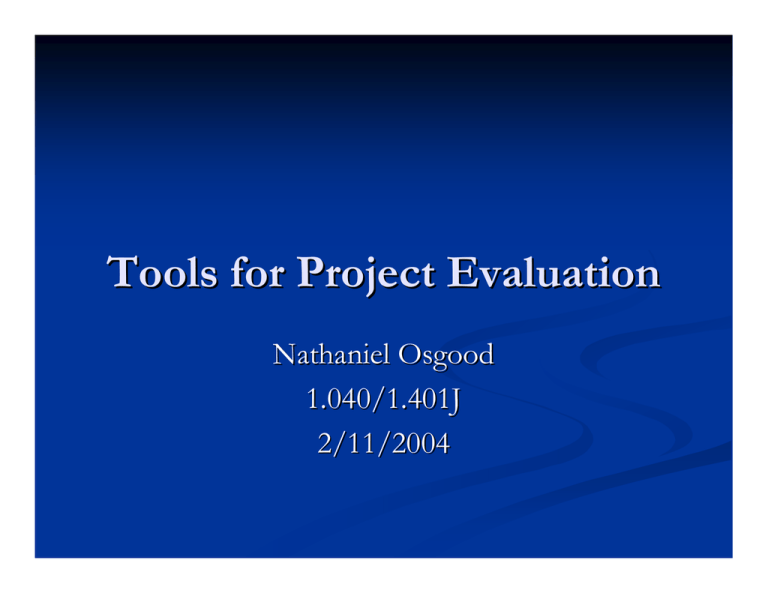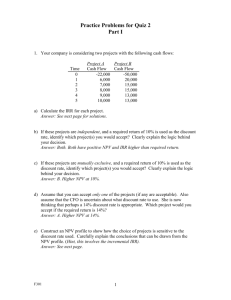Tools for Project Evaluation Nathaniel Osgood 1.040/1.401J 2/11/2004
advertisement

Tools for Project Evaluation Nathaniel Osgood 1.040/1.401J 2/11/2004 Basic Compounding Suppose we invest $x in a bank offering interest rate i If interest is compounded annually, asset will be worth $x(1+i) $x(1+i)2 $x(1+i)3 $x(1+i)n after 1 years after 2 years after 3 years …. after n years Opportunity Cost & The Time Value of Money If we assume money can always be invested in the bank (or some other reliable source) now to gain a return with interest later That as rational actors, we will never make an investment which we know to offer less money than we could get in the bank Then money in the present can be thought as of “equal worth” to a larger amount of money in the future Money in the future can be thought of as having an equal worth to a lesser “present value” of money Notation Cost Time Revenue Simple investment Equivalence of Present Values Given a source of reliable investments, we are indifferent between any cash flows with the same present value – they have “equal worth” This indifferences arises b/c we can convert one to the other with no extra expense Future to Present Revenue Given Future Revenue in year t… r Borrow a smaller amt now from reliable source r/(1+i)t r Transforms future revenue to equivalent present revenue, at no additional cost burden r/(1+i)t Future to Present Cost Given Future Cost in year t… c Invest a smaller amt now in reliable source c c/(1+i)t Transforms future cost to equivalent present cost, with no additional cost burden c/(1+i)t Present to Future Revenue Given Present Revenue… r Invest all now in reliable source; withdraw at t r(1+i)t r Transforms present revenue to equivalent future revenue, at no additional cost burden r(1+i)t Present to Future Cost Given a present cost… c Borrow = amt now from source; pay back at t c c(1+i)t Transforms current cost to equivalent future, with no additional cost burden c(1+i)t Summary Given a reliable source offering annual return i we can shift costlessly between cash flow v at time 0 and v(1+i)t at time t Because we can flexibly switch from one such value to another without cost, we can view these values as equivalent The present value of a cash flow v at time t is just v/(1+i)t Notion of Net Present Value Suppose we had A collection (or stream) of costs and revenues in the future A certain source of borrowing/saving (at same rate) The net present value (NPV) is the sum of the present values for all of these costs and revenues Treat revenues as positive and costs as negative Understanding Net Present Value NPV (and PV) is relative to a discount rate In our case, this is the rate for the “reliable source” NPV specifies the Value of the cash stream beyond what could be gained if the revenues were returns from investing the costs (at the appropriate times) in the “reliable source” The “reliable source” captures the opportunity cost against which gains are measured Key point: NPV of “reliable source” is 0 PV(revenue from investment)=PV(investment cost) Example: High-Yield Investment Assume reliable source with 10% annual interest Invest $100 in high-risk venture at year 0 Receive $121 back at year 1 What is the net present value of this investment? What is the net future value of this investment? What does this mean? $121 $100 Example: Money in Mattress Assume reliable source with 10% annual interest Place $100 in mattress at year 0 Retrieve $100 from mattress at year 1 What is the net present value of this investment? What does this mean? $100 $100 Discounted Cash Flow Computing Present Value (PV) of costs & benefits involves successively discounting members of a cash flow stream This is because the value of borrowing or investment to/from the “reliable source” rises exponentially This notion is formalized through Choice of a discount rate r In the absence of risk or inflation, this is just the interest rate of the “reliable source” (gain through opportunity costs) Applying discount factor 1/(1+r)t to values at time t Outline 9 9 Session Objective Project Financing 9 9 9 9 9 Financial Evaluation 9 9 9 Public Private Project Contractor Additional issues Time value of money Present value NPV & Discounted cash flow Simple Examples Formulae IRR Missing factors Develop or not Develop Is any individual project worthwhile? Given a list of feasible projects, which one is the best? How does each project rank compared to the others on the list? “Objective: Strive to secure the highest net dollar return on capital investments which is compatible with the risks incurred” We can EITHER Use NPV to Evaluate a project against some opportunity cost Use this opportunity to set the discount rate r > NPV = < 0 Accept the project Indifferent to the project Reject the project Use NPV to choose the best among a set of (mutually exclusive) alternative projects Rates Discount Rate: Worth of Money + risk Minimum Attractive Rate of Return (MARR) Minimum discount rate accepted by the market corresponding to the risks of a project Choice of Discount Rate Project Evaluation Example Warehouse A Construction=10 months Construction=20 months Cost = $100,000/month Cost=$100,000/month Sale Value=$1.5M Sale Value=$2.8M Total Cost? Total Cost? Profit? Profit? Better than B? Better than A? Warehouse B Pena-Mora 2003 Drawing out the examples Project A $100,000 $100,000 $100,000 $100,000 … Project B $1,500,000 10 Months $100,000 $2,800,000 20 Months $100,000 $100,000 $100,000 $100,000 $100,000 Outline 9 9 Session Objective Project Financing 9 9 9 9 9 Financial Evaluation 9 9 9 9 Public Private Project Contractor Additional issues Time value of money Present value NPV & Discounted cash flow Simple Examples Formulae IRR Missing factors Interest Formulas i = Effective interest rate per interest period (discount rate of MARR) t = Number of compounding periods PV = Present Value NPV = Net Present Value FV = Future Value A = Annuity Interest Formulas: Payments Single Payment Compound Amount Factor Single Payment Present Worth Factor (P/F, i%, n) = 1/ (1 + i )n = 1/ (F/P, i%, n) Uniform Series Compound amount Factor (F/P, i%, n) = (1 + i )n (F/A, i%, n) = (1 + i )n - 1 / i Uniform Series Sinking Fund Factor (A/F, i%, n) = i / (1 + i )n - 1 = 1 / (F/A, i%, n) Pena-Mora 2003 Interest Formulas: Series Uniform Series Present Worth Factor (P/A, i%, n) = 1/ i - 1/ i (1 + i )n Uniform Series Capital Recovery Factor (A/P, i%, n) = [i (1 + i )n] / [(1 + i )n – 1] = 1 / (P/A, i%, n) Pena-Mora 2003 Note on Continuous Compounding To this point, we have considered annual compounding of interest Consider more frequent compounding Interest is in %/year Fraction of interest gained over time ∆t (measured in years)=i∆t For n compounding periods/year, effective rate for entire year is i⎞ ⎛ 1 + ⎜ ⎟ ⎝ n⎠ n As n→∞ we approach continuous compounding and quantity approaches ei Over t years, we have eit Equipment Example $ 20,000 equipment expected to last 5 years $ 4,000 salvage value Minimum attractive rate of return 15% What are the? A - Annual Equivalent B - Present Equivalent Pena-Mora 2003 Equipment Example Outline 9 9 Session Objective Project Financing 9 9 9 9 9 Financial Evaluation 9 9 9 9 9 Public Private Project Contractor Additional issues Time value of money Present value NPV & Discounted cash flow Simple Examples Formulae IRR Missing factors Internal Rate of Return (IRR) Identifies the rate of return on an investment Example: Geometrically rising series of values Typical means of computing: Identify the discount rate that sets NPV to 0 IRR Investment Rule r- > = Accept Indifferent Reject r* < “Accept a project with IRR larger than the discount rate.” Alternatively, “Maximize IRR across mutually exclusive projects.” Pena-Mora 2003 Internal Rate-of-Return Method (IRR) Example 0(r%) = -20,000 + 5,600 (P/A, r%, 5) + 4,000 (P/F, r%, 5) i = +/- 16.9% > 15% then the project is justified Internal Rate-of-Return Method (IRR) Graph IRR vs. NPV Most times, IRR and NPV give the same decision / ranking among projects. IRR does not require to assume (or compute) discount rate. IRR only looks at rate of gain – not size of gain IRR ignores capacity to reinvest IRR may not be unique (payments in lifecycle): Trust NPV: It is the only criterion that ensures wealth maximization Pena-Mora 2003 Other Methods I Benefit-Cost ratio (benefits/costs) or reciprocal Discounting still generally applied Accept if <1 Common for public projects Does not consider the absolute size of the benefits Can be difficult to determine whether something counts as a “benefit” or a “negative cost” Cost-effectiveness Looking at non-economic factors Discounting still often applied for non-economic $/Life saved $/QALY Other Methods II Payback period (“Time to return”) Minimal length of time over which benefits repay costs Typically only used as secondary assessment Drawbacks Ignores what happens after payback period Does not take discounting into account Discounted version called “capital recovery period” Adjusted internal rate of return (AIRR) Outline 9 9 Session Objective Project Financing 9 9 9 9 9 Financial Evaluation 9 9 9 9 9 9 Public Private Project Contractor Additional issues Time value of money Present value NPV & Discounted cash flow Simple Examples Formulae IRR Missing factors What are we Assuming Here? That only quantifiable monetary benefits matter Certain knowledge of future cash flows Present value (discounting) using equal rates of borrowing/lending Money is not Everything Social Benefits Hospital School Employment opportunities Intangible Benefits New cafeteria Strategic benefits Partnering with firm for long-term relationship We are missing critical uncertainties Revenue Level of occupancy Elasticity and Level of cost Duration of project Post-construction revenue Sale of building Environmental conditions Labor costs Size of lowest bid Variable interest rates Energy costs How quickly items wear out Labor costs Costs Construction costs Maintenance costs








